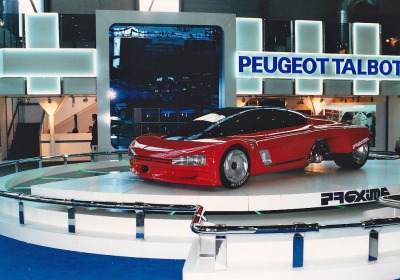Concept Car of the Week: Peugeot Proxima (1986)
Fri, 25 Apr 2014Presented at the 1986 Paris Motor Show, the Proxima concept was the ultimate vision of '80s futurism, both in terms of its design and engineering. To assert its blue-sky vision, Peugeot named its creation after Proxima Centauri, the closest star to the sun.
The exterior design was directed by Gérard Welter, and featured a long wheelbase, mid-mounted engine and very small overhangs, putting the accent on power and performance.
While the front looked like a 405 on steroids, the rear was a very dramatic piece of design. The body was made of stratified Kevlar, and included a rear dorsal fin that sat on top of the engine compartment, between two solar panels. These provided the power to regulate the temperature inside the cabin.
A thin horizontal LED strip stretched over the full width of the truncated tail to create a strong Peugeot signature. The body only covered some vital elements, leaving the fat rear tires and parts of its engine unprotected.
Looking below the car, you could see the two large turbos hanging from its exposed guts. These were coupled with two air-to-liquid intercoolers to bring the power of the 2.8-liter V6 to 600bhp. The engine also made use of ceramic-coated mechanical components to reduce power losses due to friction.
To get in, the passengers had to open the polycarbonate canopy, which is split in half. The front half rotated forward at its base while the rear half slid rearwards.
The bright red cockpit was designed by Paul Bracq, and capable of accommodating up to four passengers. It contrasted traditional handcrafted leather and quilting with high technology. Satellite navigation, an electronic key card, rear-view cameras, anti-collision radar and a visualization system that combined the input from five external cameras into a unique image of the vehicle's surroundings all featured.
The Proxima also included electronic assistance technologies that aimed to provide comfort, speed and safety. The transmission was a non permanent four-wheel drive, which transferred power to the front axle if a skid was detected, while the gearbox and clutch were electronically controlled. The future is now.
First seen Paris Motor Show 1986
Length 4,420mm
Width 2,110mm
Height 1,150mm
Wheelbase 2,750mm
Engine 2.8-liter V6, twin-turbocharged, mid mounted
Power 441.6kW/600bhp
Weight 1,080kg
Your author, Flavien Dachet, is a UK-based, French-born car designer. You may know him as the purveyor of KarzNshit, a photo blog that if it isn't already in your bookmarks, it certainly should be.
By Flavien Dachet

